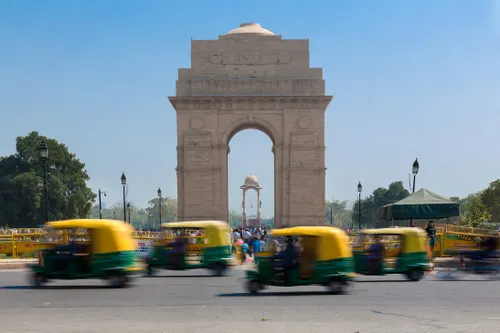On the morning of July 15, 2025, Delhi and its surrounding regions were jolted awake by a 4.4 magnitude earthquake, with its epicenter near Rohtak, Haryana. The tremors, which lasted for nearly 15-20 seconds, were felt across the National Capital Region (NCR), including parts of Gurugram, Faridabad, Noida, and Ghaziabad. Many residents described it as the “longest-lasting earthquake” they had ever experienced, sparking panic and concerns about structural safety.
The National Center for Seismology (NCS) confirmed the quake occurred at 7:58 AM IST at a shallow depth of 10 kilometers, amplifying the shaking effect. While no major damage or casualties were immediately reported, the incident has reignited discussions about Delhi-NCR’s seismic vulnerability and preparedness for larger earthquakes.
How the Earthquake Unfolded
The tremors began as a mild vibration but quickly intensified, causing furniture to shake, ceiling fans to sway, and windows to rattle. Social media was flooded with reactions within minutes, with many users sharing videos of swaying chandeliers, trembling walls, and people rushing out of buildings.
- Location: Epicenter near Rohtak, Haryana (approximately 70 km from Delhi)
- Magnitude: 4.4 (as per NCS)
- Depth: 10 km (shallow, leading to stronger surface shaking)
- Time: 7:58 AM IST
- Duration: 15-20 seconds (unusually long for a moderate quake)
Public Reaction: “Felt Like It Would Never End”
Many Delhi-NCR residents took to X (formerly Twitter), Instagram, and WhatsApp to describe their experiences:
- “I was having tea when my entire building started shaking. For a moment, I thought it was a dream.” — Ramesh Kumar, Mayur Vihar
- “The tremors just kept going—longest I’ve ever felt. My pets were terrified.” — Priya Sharma, Gurugram
- “We evacuated our office building. Some thought it was a bomb blast at first.” — Ankit Verma, Noida
The Delhi Metro briefly halted operations as a precautionary measure, while high-rise buildings in Gurugram and Dwarka reported minor cracks in walls. Fire departments and disaster response teams were put on alert, though no major structural damage was confirmed.
Why Delhi-NCR Is at Risk: Seismic Zone IV
Delhi lies in Seismic Zone IV, the second-highest risk category in India’s earthquake zoning map. This means the region is highly prone to damaging earthquakes, with historical precedents like the 1905 Kangra earthquake (7.8 magnitude) and the 2001 Bhuj earthquake (7.7 magnitude) serving as grim reminders.
Key Risk Factors:
- Proximity to Himalayan Fault Lines: The Main Boundary Thrust (MBT) and Main Central Thrust (MCT) make the region tectonically active.
- Dense Urbanization: Poorly constructed buildings in Delhi’s unauthorized colonies are highly vulnerable.
- Shallow Earthquakes: Quakes near the surface (like today’s) cause more intense shaking.
Government and Expert Response
The Union Ministry of Earth Sciences issued a statement assuring citizens that no further major aftershocks were expected. However, experts warned that Delhi-NCR must prepare for larger quakes in the future.
- Dr. OP Mishra, NCS Director: “A 4.4 magnitude quake is moderate, but the duration was unusual. Delhi must enforce stricter building codes.”
- NDMA Advisory: The National Disaster Management Authority (NDMA) urged residents to:
- Identify safe spots (under sturdy furniture, away from glass)
- Secure heavy objects (bookshelves, TVs)
- Avoid using elevators during tremors
Lessons from Past Earthquakes: Is Delhi Prepared?
While today’s earthquake did not cause major damage, it exposed gaps in public awareness and infrastructure resilience:
- Building Safety: Many high-rises in NCR lack earthquake-resistant designs.
- Emergency Drills: Few schools and offices conduct regular earthquake mock drills.
- Public Panic: Lack of awareness led to stampede-like situations in some crowded markets.
What Should Residents Do Now?
- Check Home Structures: Look for cracks in walls, beams, or foundations.
- Prepare an Emergency Kit: Include water, first aid, flashlights, and important documents.
- Follow Official Alerts: Register for NDMA’s SMS alerts for real-time updates.
Conclusion: A Wake-Up Call for Delhi-NCR
The July 15, 2025, earthquake may have been moderate, but it served as a stark reminder of Delhi’s seismic risks. With experts warning of a potential “big one” in the Himalayan region, authorities and citizens must prioritize disaster preparedness, stricter construction norms, and public awareness campaigns.
For now, the city breathes a sigh of relief—but the tremors today were a warning that should not be ignored.
Sourashis Chanda brings readers their unique perspective on Business, Economy, Health and Fitness. With a background in Health and Physical Fitness of 2years, I am dedicated to exploring [what they aim to achieve with their writing, on the sustainable Economy of the country, various pro tips about business, latest goverment news, with some tips in health are and Fitness.





